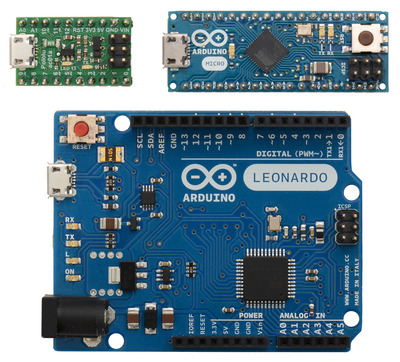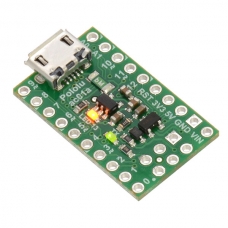A-Star 32U4 Micro
The Pololu A-Star 32U4 Micro is a general-purpose programmable module based on Atmel’s ATmega32U4 AVR microcontroller, which has 32 KB of flash program memory, 2.5 KB of RAM, and built-in USB functionality. Onboard features of the A-Star (abbreviated A*) include a 16 MHz resonator, a USB Micro-B connector, an in-system programming (ISP) header, and a pair of indicator LEDs. A voltage regulator and power selection circuit allow the board to be powered from either USB or an external 5.5 V to 15 V source, while a resettable PTC fuse on the USB VBUS supply and reverse protection on VIN help protect it from accidental damage.
The A-Star 32U4 Micro breaks out 15 general-purpose I/O lines along two rows of pins, including 7 usable as PWM outputs and 8 usable as analog inputs. It fits all this into a 20-pin dual in-line package (DIP) measuring only 1″ × 0.6″ (even smaller than competing ATmega32U4 boards like the Teensy 2.0 and Pro Micro), and its 0.1″ pin spacing makes the A* easy to use with solderless breadboards, perfboards, and 0.1″-pitch connectors.
Our comprehensive user’s guide provides the basics you need to get started with the A-Star as well as detailed technical information for advanced users.
Arduino compatibility
The A-Star 32U4 ships with a preloaded Arduino-compatible bootloader (which uses 4 KB of flash memory, leaving 28 KB available for the user program). We provide a software add-on that enables the board to be easily programmed from the Arduino environment.
The A-Star 32U4 uses the same microcontroller as the Arduino Leonardo and Arduino Micro and runs at the same frequency, making it just as powerful. Although the larger boards offer a few more I/O pins, the A-Star 32U4 Micro fits in an area half that of the Arduino Micro, and it takes up only 11% as much area as a standard full-size Arduino!
 |
| Pololu A-Star 32U4 Micro, Arduino Micro, and Arduino Leonardo. |
|---|
Features
- Dimensions: 1″ × 0.6″ (1.05″ × 0.6″ including USB Micro-B connector)
-
Programmable 16 MHz Atmel ATmega32U4 AVR microcontroller
- 32 KB flash (4 KB used by bootloader, leaving 28 KB available for user program by default)
- 2.5 KB SRAM
- 1 KB EEPROM
- Native full-speed USB (12 Mbps)
- Preloaded with Arduino-compatible bootloader (no external programmer required)
-
Many I/O lines in a small package
- 15 general-purpose I/O pins available along the sides of the board
- 3 additional I/O pins available on ISP header
- 7 pins can be configured as hardware PWM outputs
- 8 pins can be configured as analog inputs
- 2 user-controllable LEDs
- Can be powered from USB or external 5.5 V to 15 V source on VIN
- PTC fuse on VBUS supply
- Reverse-voltage protection on VIN supply
- 6-pin ISP header for use with an external programmer
- Comprehensive user’s guide
Pinout
 |
This diagram identifies the I/O and power pins on the A-Star 32U4 Micro; yellow labels represent digital I/O pins and green labels represent analog input channels. Light text on a dark background indicates Arduino digital and analog pin numbering, while dark text on a light background indicates a name or function of the pin as defined in the ATmega32U4 datasheet. For more information about the ATmega32U4 microcontroller on this board, see Atmel’s ATmega32U4 documentation.
Printed on the A* circuit board are indicators that you can use to quickly identify each pin’s capabilities: a triangle next to the pin means it can be used as an analog input, and a square wave symbol under the pin number means it can be used as a PWM output.
The board can either be powered directly from the USB 5 V supply or from a separate 5.5 V to 15 V source on the VIN pin, which is reduced to 5 V by a 100 mA low-dropout (LDO) regulator; you can access this 5 V supply through the 5V power output pin. Additionally, the ATmega32U4 contains an internal 3.3 V regulator whose output is available on the 3V3 pin. Current drawn from the 3V3 output should not exceed about 50 mA, and when the board is being powered through VIN, the sum of the 5V output current, 3V3 output current, GPIO output current, and current used by the board itself (typically about 25 mA) should not exceed 100 mA.
Write a review
Your Name:Your Review: Note: HTML is not translated!
Rating: Bad Good
Enter the code in the box below:





